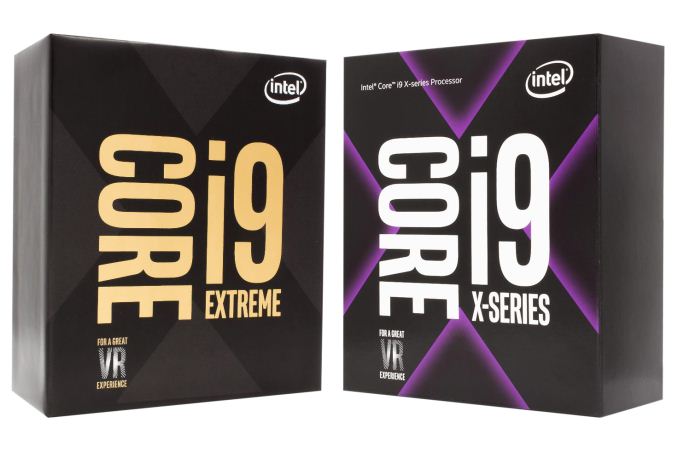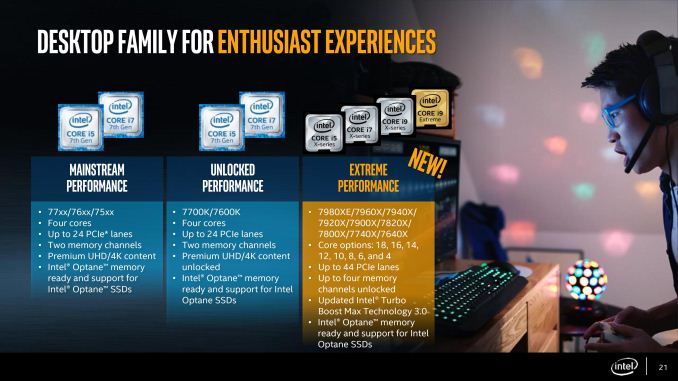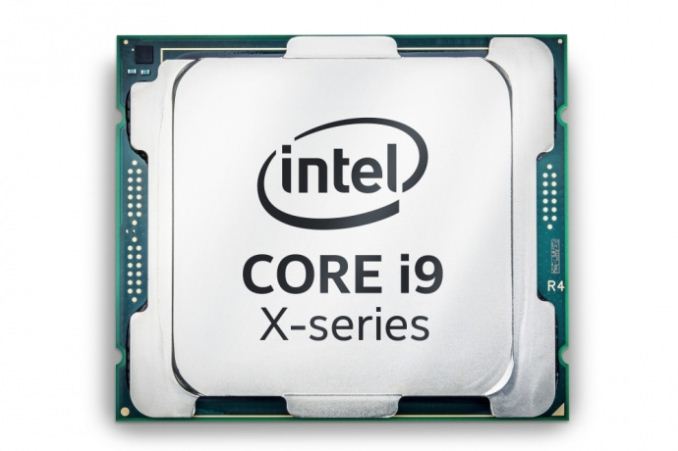Intel Announces Skylake-X: Bringing 18-Core HCC Silicon to Consumers for $1999
by Ian Cutress on May 30, 2017 3:03 AM EST
There are days in this profession in which I am surprised. The longer I stay in the technology industry, they become further and further apart. There are several reasons to be surprised: someone comes out of the blue with a revolutionary product and the ecosystem/infrastructure to back it up, or a company goes above and beyond a recent mediocre pace to take on the incumbents (with or without significant financial backing). One reason is confusion, as to why such a product would ever be thought of, and another is seeing how one company reacts to another.
We’ve been expecting the next high-end desktop version of Skylake for almost 18 months now, and fully expected it to be an iterative update over Broadwell-E: a couple more cores, a few more dollars, a new socket, and done. Intel has surprised us with at least two of the reasons above: Skylake-X will increase the core count of Intel’s HEDT platform from 10 to 18.
The Skylake-X announcement is a lot to unpack, and there are several elements to the equation. Let’s start with familiar territory: the first half of the processor launch.
Announcement One: Low Core Count Skylake-X Processors
The last generation, Broadwell-E, offered four processors: two six-core parts, an eight-core part, and a top-tier 10-core processor. The main difference between the two six-core parts was the PCIe lane count, and aside from the hike in pricing for the top-end SKU, these were iterative updates over Haswell-E: two more cores for the top processor.
This strategy from Intel is derived from what they call internally as their ‘LCC’ core, standing for ‘low core count’. The enterprise line from Intel has three designs for their silicon – a low core count, a high core count, and an extreme core count: LCC, HCC, and XCC respectively. All the processors in the enterprise line are typically made from these three silicon maps: a 10-core LCC silicon die, for example, can have two cores disabled to be an 8-core. Or a 22-core XCC die can have all but four cores disabled, but still retain access to all the L3 cache, to have an XCC processor that has a massive cache structure. For the consumer HEDT platform, such as Haswell-E and Broadwell-E, the processors made public were all derived from the LCC silicon.
The first half of the Skylake-X processor llineup follows this trend. Intel will launch four Skylake-X processors based on the LCC die, which for this platform will have a maximum of 12 cores. All processors will have hyperthreading.
| Skylake-X Processors (Low Core Count Chips) | ||||
| Core i7-7800X | Core i7-7820X | Core i9-7900X | Core i9-7920X | |
| Cores/ Threads |
6/12 | 8/16 | 10/20 | 12/24 |
| Base Clock | 3.5 GHz | 3.6 GHz | 3.3 GHz | TBD |
| Turbo Clock | 4.0 GHz | 4.3 GHz | 4.3 GHz | TBD |
| TurboMax Clock | N/A | 4.5 GHz | 4.5 GHz | TBD |
| L3 | 8.25 MB | 11 MB | 13.75 MB | TBD (Likely 13.75 MB) |
| PCIe Lanes | 28 | 44 | TBD (Likely 44) |
|
| Memory Channels | 4 | |||
| Memory Freq | DDR4-2400 | DDR4-2666 | TBD | |
| TDP | 140W | TBD | ||
| Price | $389 | $599 | $999 | $1199 |
The bottom processor is the Core i7-7800X, running at 3.5 GHz with a 4.0 GHz turbo. This design will not feature Intel’s new ‘favored core’ Turbo 3.0 technology (more on that below), but will have six cores, support quad-channel memory at DDR4-2400, come in at a TDP of 140W, have 28 PCIe lanes, and retail for around $400. This processor will be the entry level model, for any user who needs the benefit of quad-channel memory but perhaps doesn’t need a two-digit number of cores or has a more limited budget.
Next up is the Core i7-7820X, which hits a potential sweet spot in the LCC design. This is an eight-core processor, with the highest LCC base clock of 3.6 GHz and the joint-highest turbo settings: 4.3 GHz for regular turbo and 4.5 GHz for favored core. Unlike the previous processor, this CPU gets support for DDR4-2666 memory.
However in another break from Intel’s regular strategy, this CPU will only support 28 PCIe lanes. Normally only the lowest CPU of the HEDT stack would be adjusted in this way, but Intel is using the PCIe lane allocation as another differentiator as a user considers which processor in the stack to go for. This CPU also runs in at 140W, and comes in at $600. At this price, we would expect it to be competing directly against AMD’s Ryzen 7 1800X, which will be the equivalent of a generation behind in IPC but $100 cheaper.
| Comparison: Core i7-7820X vs. Ryzen 7 1800X | ||
| Intel Core i7-7820X |
Features | AMD Ryzen 7 1800X |
| 8 / 16 | Cores/Threads | 8 / 16 |
| 3.6 / 4.3GHz (4.5 GHz TMax) |
Base/Turbo | 3.6 / 4.0 GHz |
| 28 | PCIe 3.0 Lanes | 16 |
| 11 MB | L3 Cache | 16 MB |
| 140 W | TDP | 95 W |
| $599 | Price (MSRP) | $499 |
The third processor is also a change for Intel. Here is the first processor bearing the new Core i9 family. Previously we had Core i3, i5 and i7 for several generations. This time out, Intel deems it necessary to add another layer of differentiation in the naming, so the Core i9 naming scheme was the obvious choice. If we look at what the Core i9 name brings to the table, the obvious improvement is PCIe lanes: Core i7 processors will have 28 PCIe lanes, while Core i9 processors will have 44 PCIe lanes. This makes configuring an X299 motherboard a little difficult: see our piece on X299 to read up on why.
Right now the Core i9-7900X is the only Core i9 with any details: this is a ten core processor, running with a 3.3 GHz base, a 4.3 GHz turbo and a 4.5 GHz favored core. Like the last processor, it will support DDR4-2666 and has a TDP of 140W. At this level, Intel is now going to charge $100/core, so this 10-core part runs in at a $999 tray price ($1049 retail likely).
One brain cell to twitch when reading this specification is the price. For Ivy Bridge-E, the top SKU was $999 for six-cores. For Haswell-E, the top SKU was $999 for eight-cores. For Broadwell-E, we expected the top SKU for 10-cores to be $999, but Intel pushed the price up to $1721, due to the way the enterprise processors were priced. For Skylake-X, the new pricing scheme is somewhat scrapped again. This 10-core part is now $999, which is what we expected the Broadwell-E based Core i7-6950X to be. This isn’t the top SKU, but the pricing comes back down to reasonable levels.
Meanwhile for the initial launch of Skylake-X, it is worth noting that this 10-core CPU, the Core i9-7900X, will be the first one available to purch. More on that later.
Still covering the LCC core designs, the final processor in this stack is the Core i9-7920X. This processor will be coming out later in the year, likely during the summer, but it will be a 12-core processor on the same LGA2066 socket for $1199 (retail ~$1279), being part of the $100/core mantra. We are told that Intel is still validating the frequencies of this CPU to find a good balance of performance and power, although we understand that it might be 165W rather than 140W, as Intel’s pre-briefing explained that the whole X299 motherboard set should be ready to support 165W processors.
In the enterprise space, or at least in previous generations, Intel has always had that processor that consumed more power than the rest. This was usually called the ‘workstation’ processor, designed to be in a single or dual socket design but with a pumped up frequency and price to match. In order for Intel to provide this 12-core processor to customers, as the top end of the LCC silicon, it has to be performant, power efficient, and come in at reasonable yields. There’s a chance that not all the factors are in place yet, especially if they come out with a 12-core part that is clocked high and could potentially absorb some of their enterprise sales.
Given the expected timing and launch for this processor, as mentioned we were expecting mid-summer, that would have normally put the crosshairs into Intel’s annual IDF conference in mid-August, although that conference has now been canned. There are a few gaming events around that time to which Intel may decide to align the launch to.












203 Comments
View All Comments
SaturnusDK - Thursday, June 1, 2017 - link
The infinity fabric seems to be working fine with minimal scaling performance loss for the Ryzen chips already on the market so there's no reason to believe that extending the bus will incur a severe performance penalty.rocky12345 - Thursday, June 1, 2017 - link
I got to ask Anandtech site gives all of this love to Intel for releasing products we already expected except for the 18/36 CPU (Thanks AMD for getting fire under Intel's butt again). What I am saying is there are at least three headlines for the Intel crap but one little byline for AMD's threadripper crap. I like Anandtech and all but AMD's release is way more important to the industry than this Intel release because of it were not for AMD new CPU line Intel would have just once more released a ho hum product with little extra to offer and probably $500 or more than the prices they are now asking. Give credit where credit is needed. You say new stuff in the industry does not excite you much anymore. Well for me and hopefully anyone else with a brain are more excited for the New AMD tech than this rehashed Intel tech. ThanksKalliMan - Friday, June 2, 2017 - link
There is a "small" mistake here. The price of 1800X is now ~ 429-449. You are comparing 2 CPUS with that belong to completely different price ranges( 1800X is 150- 170 $ cheaper than 7872X) . And be sure in Multitasking it will be superior.cekim - Friday, June 2, 2017 - link
To all those prattling on about how such processors have no market or purpose, I direct your attention to ebay... clearly you are wrong. The question is not whether there is a market for consumer HCC chips, the question is what that market is willing to pay for them?alpha754293 - Friday, June 2, 2017 - link
re: the whole AMD vs. Intel thing all over againI'm not worried about AMD as a threat at all.
Their latest processor, on some workloads, still barely beats an Intel Core i5(!) or can only beat some of the mid-range Core i7s at best.
I've long been an "AMD guy" because they used to be a value proposition - where you can get decent performance at a much lower price compared to the Intel counterparts.
But times have changed and that isn't really quite the case anymore. AMD CPUs really aren't that much cheaper compared to Intel's, but Intel's CPUs perform SIGNIFICANTLY better than AMD (mostly because AMD went the way of the UltraSPARC Niagara T1, by having only ONE FPU shared across multiple ALUs) - and of course, the problem with THAT design idea/approach is that fundamentally, CPUs are massively glorified calculators.
And AMD choose to cripple their product's ability to do calculations.
People have a tendency to want to focus on IPCs (as it is here). But really, you need both IPC AND FLOPs and a MUCH BETTER metric to compare against is FLOP/clock (because it tells you about the processor's computational efficiency), which almost NO one writes about anymore.
I'm already running 16 cores acrossed three systems and I just make the requisition for a 64-core system.
The "thing" that I have found/discovered with systems that have lots and lots of cores is that you REALLY WANT, should, and NEED to have ECC RAM because if you try to get it to do many things at once, in order to prevent issues with the programs interfering with each other, the ECC is a patch-style method that can help correct some of that.
When I've launched 6 runs of a computationally intensive task at once, some of them fail because my current systems don't have ECC Registered RAM (and I am not sure if the CPU knows what to do with it (being that the memory controller is on-die) and to deal with and work with memory coherency.
While it might be a welcome changed on the ultra high end, extreme enthusiast front, you can get a system that does a LOT more for a LOT less than what it would cost you to use these processors by using server grade hardware (albeit used - which, in my opinion, if it still works, why not? I don't see anything "wrong" with that.)
A system using the new 16-core CPU is likely going to run you between $3000-5000. The system that I just bought has 64 cores (four times more) with 512 GB of RAM for the same price.
Meteor2 - Saturday, June 3, 2017 - link
Literally TL;DR.Lolimaster - Saturday, June 3, 2017 - link
If you mean low threaded then you need to look at the Ryzen 5 1400-1500X which is 90% of the i7 7700 and its obviously "better" than the top of the line Ryzen at "some workloads, mean lower thread apps/games",$160-190, rip intel.
Gothmoth - Sunday, June 4, 2017 - link
so much words for trolling.... you took the time to write so much but when it comes to what you supposedly bought you suddenly become unspecific.... no letters and words to write it out you can only say "The system that I just bought ".twtech - Friday, June 2, 2017 - link
So what are some common applications for this many cores? Rendering, compiling large C++ projects like Unreal 4 for example. It may not be huge, but there is a market for more cores, and Intel doesn't want AMD taking all of it.slickr - Saturday, June 3, 2017 - link
So not only are they introducing less cores overall than AMD's threadripper at 32/64, they also cost a ton more money, require a new socket, it features locked overclocking and they cost more than AMD's equivalents.Intel really do have nothing, they announced their 14/16/18 cores, but they have no info on them, meaning it was a last minute thing, where they would only be available late 2017, but they have nothing else to go against AMD, so they are playing a move to trick people into thinking they have products up and coming soon, when they don't.